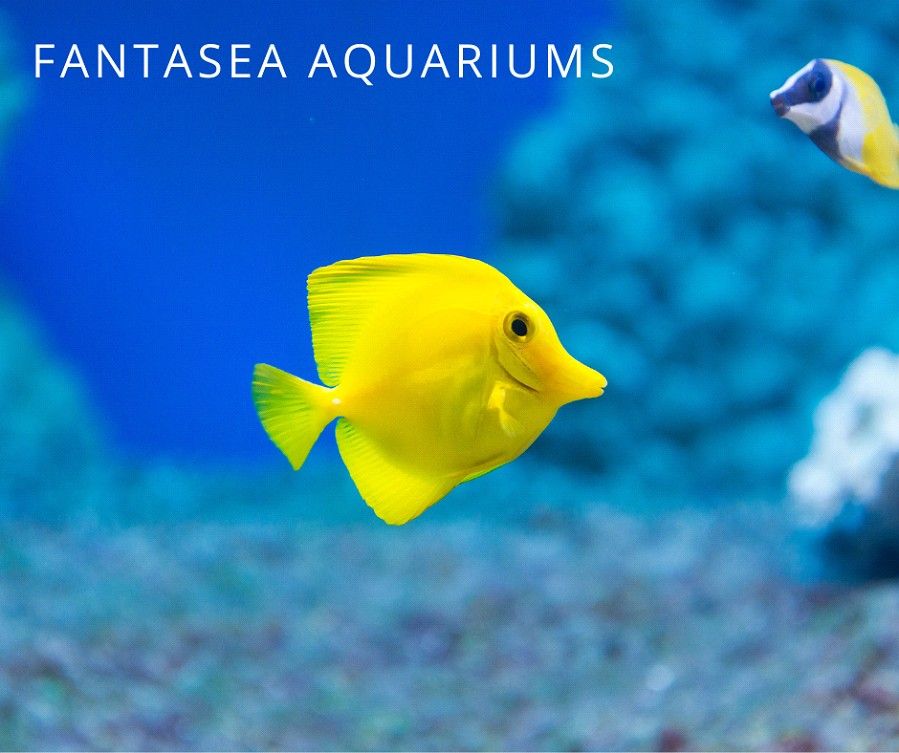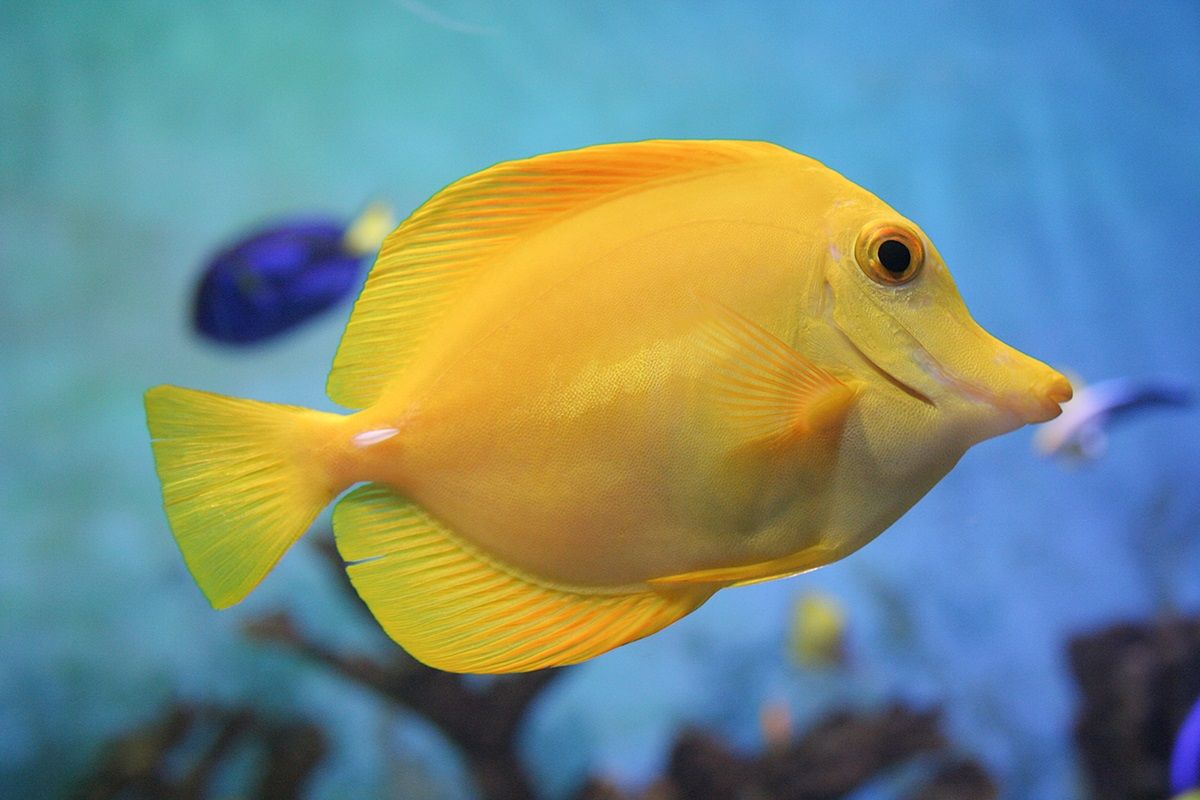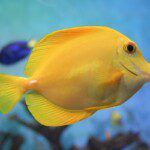Even if you’re brand new to the aquarium hobby, the yellow tang (Zebrasoma flavescens) is one fish species you’ve probably already heard of. Named for its bright neon yellow color, this species is a long-time aquarium favorite. It makes a great addition to the larger saltwater tank.
Keep reading for everything you need to know about yellow tang care and keeping this beautiful fish in your own aquarium!
| Name (Common, Scientific) | Yellow tang, yellow surgeonfish, Zebrasoma flavescens |
| Minimum tank size | 90 gallons |
| Minimum group size | 1 |
| Temperature | 72-82 °F |
| Salinity | 1.020-1.025 |
| pH | 8.1-8.4 |
| Difficulty level | Easy |
Yellow tang (Zebrasoma flavescens) description & natural habitat
Description
It’s not difficult to see why the yellow tang has long been a staple in the aquarium hobby. It’s hard to top that bright yellow color! These fish grow to an adult length of about 8”, with males being larger than females.
Members of the surgeonfish family Acanthuridae, these tangs sport a sharp protective spine on the side of their tail fins, called the scalpel. They have long snouts and flat, disc-shaped bodies.
Telling the difference between male and female yellow tangs is challenging. Adult males are generally a bit larger, and they’ve been noted to sport bristle-like scales around their scalpel. However, it’s really not very easy to spot.
Did you know? Yellow tangs’ bright coloration fades during the night, something that has spooked many an aquarist upon turning the aquarium lights on in the morning. No worries, your tang is fine and will be back to normal before you know it.
Natural habitat
Yellow tangs are naturally found in the Pacific. Specifically, they inhabit coral reefs from the Philippines in the west to southern Japan, island groups like the Marshall Islands, and finally Hawaii in the east, where they’re most common.
In its natural habitat, this species can be found at a depth of up to 260ft, although it usually stays shallower. Adult yellow tangs in particular tend to leave deeper reefs for shallower waters and spend the rest of their lives there
The IUCN Red List considers Zebrasoma flavescens to be a species of Least Concern in the wild. It notes that despite it being one of the most commonly collected aquarium fish, and the fact that the population does appear to have decreased in some places, it’s still locally common.
“Safe zones” are in place in much of this species’ natural range, which protects it from collection and fishing.
Did you know? Yellow tangs can live very long lives. In one study, the oldest individual collected was a whopping 41 years old!
Claisse, Kienzle, Bushnell, Shafer, & Parrish (2009)

Yellow tang (Zebrasoma flavescens) aquarium
Unfortunately for nano aquarium enthusiasts, yellow tangs need a bit of space to thrive due to their adult size and activity level. They’re always grazing and zooming around the tank looking for bits of food! An aquarium of 90 gallons or up is a good idea.
Plenty of live rock and other décor will help your tang feel safe, but forget to provide enough open swimming space either. This way, your tang can explore, forage and graze freely.
Make sure the tank is fully cycled. Although yellow tangs can be relatively hardy, they really don’t respond well to fluctuating water values. Water surface agitation is also important: hobbyists report their yellow tangs struggling or even dying due to lack of oxygen without good water flow.
Lastly, and quite importantly, be careful if you ever have to catch your tang. It’s best to stay well out of reach of that sharp tail spur.
Did you know? Despite their popularity, yellow tangs are not the most well-known member of the surgeonfish family. That would be the blue tang (Paracanthurus hepatus), which gained its fame with its appearances in Finding Nemo and Finding Dory.
Yellow tang (Zebrasoma flavescens) compatibility
The yellow tang is not considered the most peaceful species in the aquarium hobby. It tends to squabble with other fish, although this should usually not be anything too serious. The most important thing to keep in mind is that they don’t always respond too well to the presence of other tangs and surgeonfish.
Yellow tangs do loosely school in very large (and particularly very long) aquariums. However, we don’t recommend keeping more than one unless you really have a good amount of swimming space to offer, like a tank that’s 8ft long or more.
It’s best to introduce all fish at the same time. This can help prevent territorial squabbles by ensuring no one has an established territory that it wants to defend from new additions. The last thing you want is your yellow tang slashing its tankmates with that tail spine!
Are yellow tangs reef safe?
Yellow tangs are generally considered tentatively reef safe. They’re herbivores that don’t eat coral, although they can sometimes cause issues by using your corals as their algae grazing grounds.
Depending on the coral, it might not appreciate being pecked at constantly, causing it to close up or even wither away in extreme cases. Problems are not that common, but you may want to keep your most expensive corals away from your yellow tang.

Yellow tang (Zebrasoma flavescens) diet
As mentioned above, the yellow tang is naturally a herbivore, mostly an algae eater. In the wild, individuals or small groups of this species scour the reef for suitable grazing patches. They even provide cleaning services to marine turtles!
In the aquarium, feed your yellow tang plenty of plant-based foods. Dried seaweed (nori), algae tablets, blanched veggies and spirulina flakes are all great options. You can supplement these with some meaty foods; frozen food options like mysis will be happily gobbled up.
Lastly, take it easy on the cleaning. We humans might prefer a sparkling aquarium, but your yellow tang will greatly appreciate it if you leave some algae patches for it to graze on.
Breeding yellow tangs
Yellow tangs start out their lives as tiny larvae, which drift along the current until they metamorphose into proper baby fish. Scientists have found that during this time, the tiny tangs can end up over 100 miles away from where they started, helping to “seed” areas with new fish.
The incredibly small size and picky eating habits of yellow tang larvae make this fish—whose spawning times coincide with moon cycles—pretty much impossible to raise in the home aquarium.
It was actually long thought yellow tangs couldn’t be bred in captivity at all, but lo and behold: just when Hawaii banned the export of this species (one of the most popular aquarium fish of all), the HPU or Hawaii Pacific University managed to do it.
The first captive-bred yellow tangs were produced in 2015, and since then, commercial hatcheries have become reasonably good at raising the larvae. Alas, we still don’t know anyone who’s done it at home, but at least wild-caught specimens will hopefully become rarer and rarer in the aquarium trade.
We’re very passionate about tank-bred fish and protecting wild populations. You can read more in the full post on yellow tang aquaculture!
Conclusion
For many of our clients, a reef isn’t a reef without the ubiquitous yellow tang. We have to say we’re somewhat inclined to agree! If you’re dreaming of your own saltwater aquarium (with or without a tang), shoot us a message here and we can help make it happen.
Sources & further reading
Callan, C. K., Burgess, A. I., Rothe, C. R., & Touse, R. (2018). Development of improved feeding methods in the culture of yellow tang, Zebrasoma flavescens. Journal of the World Aquaculture Society, 49(3), 493-503.
Christie et al. (2010). Larval connectivity in an effective network of marine protected areas. PloS one, 5(12), e15715.
Claisse, J. T., Kienzle, M., Bushnell, M. E., Shafer, D. J., & Parrish, J. D. (2009). Habitat-and sex-specific life history patterns of yellow tang Zebrasoma flavescens in Hawaii, USA. Marine Ecology Progress Series, 389, 245-255.




